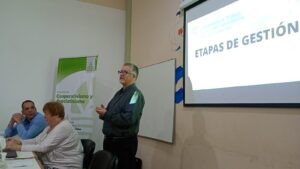“Estamos convencidos de que la autogestión, el esfuerzo propio,
la ayuda mutua y el trabajo colectivo son los pilares fundamentales para
el desarrollo humano y el crecimiento conjunto y solidario tanto del sector
como de la sociedad en su totalidad.”
QUIÉNES
SOMOS
Somos una empresa social y solidaria dedicada al cuidado
domiciliario de adultos mayores y personas con
discapacidad o con enfermedades crónicas. La Cooperativa
está integrada por cuidadores domiciliarios cooperativos.
Actualmente, la Cooperativa está conformada por 130
asociados y atiende a más de 100 pacientes; recibiendo
solicitudes de distintas organizaciones relacionadas con la
salud, de médicos geriatras, gerontólogos y
recomendaciones de familiares que han utilizado nuestros
NUESTRO SERVICIO

- Acompañamiento y asesoramiento en la vida diaria
- Administración de medicación por vía oral y de uso externo, indicados o prescriptos por profesionales
- Preparación de alimentos, ingesta asistida
- Higiene y arreglo personal
- Acciones preventivas de accidentes
- Actividades recreativas y ocupacionales acorde a sus posibilidades
- Colaboración en las prácticas indicadas por el profesional
- Control de signos vitales
NOVEDADES

Día de las Madres
💖 En este Día de las Madres celebramos a quienes cuidan con amor cada día.Desde la Cooperativa Cuidadores Domiciliarios MDP,

Taller presencial “Cooperativas y Cuidados” en Concordia E.R.
Participamos este jueves 16 de octubre del taller presencial “Cooperativas y Cuidados”, en la Sala de Capacitaciones Laborales del Centro

Charla abierta sobre Alzheimer y otras demencias
🧠 Charla abierta sobre Alzheimer y otras demencias La Cooperativa de Cuidadores Domiciliarios Mar Del Plata invita a participar de

